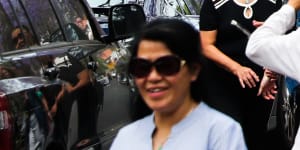Ask why there are so many jacaranda trees around Kirribilli and North Sydney and you will likely hear a story about saplings being given to new parents on their departure from Royal North Shore Hospital.

Jacarandas bring tourists to McDougall Street in Kirribilli each year.Edwina Pickles
The tale is not true – but it soon could be,with North Sydney Council expected to vote for a “trees for newborns” program at its meeting on Tuesday evening,amid concerns about a loss of greenery on the city’s lower north shore.
According to business papers published ahead of the meeting,the council’s overall tree canopy has declined by 11.7 per cent since 2008,with the drop mainly due to trees being cut down on private property,as well as.
The council’s Urban Forest Strategy,passed in 2019,seeks to reach a target of 34.4 per cent canopy cover in the area by 2036.
Under the proposal,new parents in the area would be able to apply for a tree on the council’s website,which would be delivered to their home. The council recorded 964 births in 2021.
Cr Georgia Lamb,who has championed the scheme,said the jacaranda baby myth was a well-known story among locals.
“While it is not necessarily true,it holds a great sentimental power over certain neighbourhoods,” Cr Lamb said.
Council will consider whether to pursue a 12-month trial of a program handing out only jacaranda saplings,which typically cost $20 each,or a program offering parents a choice of a jacaranda or a comparably cheaper native sapling.
Lamb,a committee member of the Sustainable Australia Party,said the second option was her preference.
“It was never my overall objective to encourage planting only jacaranda trees,but[to encourage the planting of] all species,in particular natives which hold the most ecological benefits for our communities,” she said.
The council’s urban forest officer Jessica Karam has also recommended this option,although her assessment raised some concerns about whether such a scheme would adequately boost tree cover.
Eighty-five per cent of residential dwellings in North Sydney Council are apartments,so the program will require support from strata schemes to be effective.
The council’s Urban Forest Strategy also sets out that no individual tree genus should exceed 10 per cent of its tree canopy. With jacaranda making up 5.73 per cent of North Sydney’s street trees in 2022,there is a risk such a program could result in jacarandas exceeding the 10 per cent limit.
Then there is the issue of entrusting tree replacement to the public.
“A family welcoming a newborn(s) would need a tree species that does not require intensive or extensive care after planting,” the assessment read.
“Jacarandas require moderate establishment since they are an exotic species,however they are showing good adaptation to the North Sydney environment.”
Like all urban myths,the jacaranda saplings story has a seed of truth.
Native to Brazil,the first jacaranda in Sydney was
While a spokesperson for Northern Sydney Local Health District confirmed no hospital sapling program existed on the north shore,it is possible some gifting occurred,inspired by the work of Sister Irene Haxton at her Jacaranda Maternity Hospital in Woolooware in the 1950s,whose sapling gifts for new parents contributed to the number of the trees in Sutherland Shire.
In 2020,Sutherland Hospital ran a sapling gifting program,inspired by Haxton’s work.
The Morning Edition newsletter is our guide to the day’s most important and interesting stories,analysis and insights..